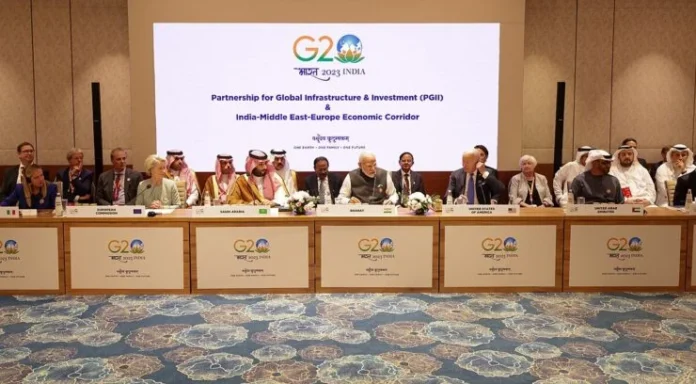Diplomacy is all about new changes. It is solution-oriented and is a manifestation of the positive aspects of human nature. In the context of global geopolitics, it aims, at least in this era of globalisation, to promote greater connectivity and greater prosperity by expanding the global community’s moral circle. The indispensable way to achieve this noble goal is to promote trade and commerce.
The 1990s and 2000s saw global efforts at bolstering global connectivity; that happened but the level of global integration remained unsatisfactory. Fast forward to 2013, we see China launch the Belt & Road Initiative (BRI), an infrastructure corridor that spanned the globe; its ostensible aim is to revive the Old Silk Road, symptomatic of global Chinese dominance.
The BRI currently spans over 100 countries; it has played a crucial role in the promotion of Beijing’s global reputation. However, its alternative has arrived – the India-Middle East-Europe corridor.
What is IMEC?
Launched during the G20 summit in Delhi, The India-Middle East-Europe corridor is an economic and infrastructure corridor that would include India, Egypt, Italy, the UAE, Saudi Arabia, the USA, Egypt, Israel, Jordan, and South Africa.
It will involve a northern and eastern route. The northern route will connect Saudi Arabia and the UAE via Israel and Jordan with a network of shipping and railway routes to promote trade and investment.
The eastern route will go via India across the western seaboard in the Arabian Sea. The northern route will pass through Italy spanning, in the years to come for the rest of Europe. A very important nodal point is the presence of Egypt in this corridor, which will serve as a link between North Africa and the Middle East or West Asia. The corridor will extend all the way up to the USA in the North American continent.
IMEC includes roughly one third of humanity, almost 54% of global GDP, and the presence of strong multilateral financial institutions financing the deal such as the International Monetary Fund and the World Bank.
IMEC is meant to promote the idea of global connectivity by bolstering the process of infrastructure creation via a cobweb network of railways, roadways, shipping lanes and even air routes.
Gives India an edge
For more than a decade, India was on the lookout for a project that could rival the Belt and Road Initiative of China. India was resolutely opposed to the BRI on the grounds of violation of her sovereignty.
The IMEC in that context gives a strong edge to India vis-a-vis China. China’s BRI is suffering from allegations of debt-trap diplomacy, which has already bankrupted countries such as Maldives and Sri Lanka, and is doing so in Cambodia.
Having said that, what makes the IMEC significant for India is the transparent nature of funding and the sustainable nature of materials that will be used to finance the projects. It has been announced that green bonds will be used in the infrastructure projects and the construction materials will be largely carbon neutral to reduce the emission of greenhouse gases such as carbon dioxide. In fact, this corridor is only expediting India’s climate goals that it had promised as a part of the INDC or Intended Nationally Determined Contribution – India’s climate plan that it submitted at the time of the Paris Climatic Accord or COP-21 in 2015.
Further, this is going to give a big boost to New Delhi’s ambition of attracting foreign investment. The world is already miffed at China’s deliberate disruption of supply chains of critical goods that wrought immense suffering at the time of the COVID-19 pandemic, and companies are looking for opportunities to relocate their bases elsewhere.
While Vietnam and South Korea are plausible options, India is perhaps the best in terms of a cost-effective workforce that is highly skilled and mobile, and India’s favourable business climate, especially in the infrastructure sectors.
It also bolsters India’s reputation as a suitable alternative to a Sinic world order that is outright authoritarian. It also buttresses India’s potential to spread the message of transparent governance in the process of infrastructure building.
Road ahead
The road ahead will perhaps not be easy in terms of mobilising capital, greenhouse emissions and realpolitik concerns. But New Delhi with its immense reputation and diplomatic capital may prove to be strong enough to give this ambitious project the light of the day.
-The writer is currently working as a Research Associate at Defence Research and Studies (dras.in) and is a columnist. The views expressed are personal and do not necessarily reflect the views of Raksha Anirveda
–The writer is currently working as a Research Associate at Defence Research and Studies (dras.in) and is a columnist. The views expressed are personal and do not necessarily reflect the views of Raksha Anirveda














